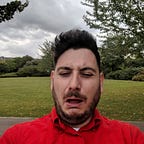Shows on paper — A Kettle of Fish.
Documenting The Process of Designing A Kettle of Fish.
For as long as I have been making theatre i’ve had a certain intrigue about the great wealth of material that is never seen by an audience. I usually fill a notebook a show, brimming with sketches and questions, quotes, sentences expressing conclusions about how things should feel or look, and more questions — all never to be shared (usually). Then maybe 50 to 100 reference images. I am so interested in how personal the act of design is. The consequence perhaps, coupled with theatre being about outcome rather than process is that we rarely see what it might look like to design. Even less so for design disciplines that are light, sound or video based! So i’ve a personal project underway to publish snippets of what i’ve been thinking or seeing whilst making work. The outcome, no idea. A time capsule perhaps? Maybe we’ll discover a through-line.
It’s import to stress that every show is different. And every designer is different. The way I work, or I should say — have grown to enjoy working is seeing the process of designing lighting as a journey. That is to say I allow the light to develop throughout rehearsals, as opposed to pinning down all the specifics from the outset. Light to me should always be responsive to the moment — the moment of creation, not the textual moment. I’m a believer that light is a key collaborator in the creation of the show, so I tend to design in the room, you’ll see what this might look like below.
I was lucky enough to part of early conversations about design with director Caitlin McLeod and designer Ingrid Hu. For us the journey has been about how we might stage this visceral and at times anarchic text that drifts from minute detail to the unconscious rambling and back again.
There is a maxim that Lighting Designers can’t draw — and I am certainly fuelling that fire!
Something that i’ve taken to as a matter of course when designing shows is making a playlist for each show, I find it a helpful way to start thinking about rhythm and pace, which of course is also the rather less visible jobs of a lighting design. Again it’s a way of starting to embody how the show feels and moves.
You can see the reference imagery from this production here.
Also, you can see how it panned out in real life here.
